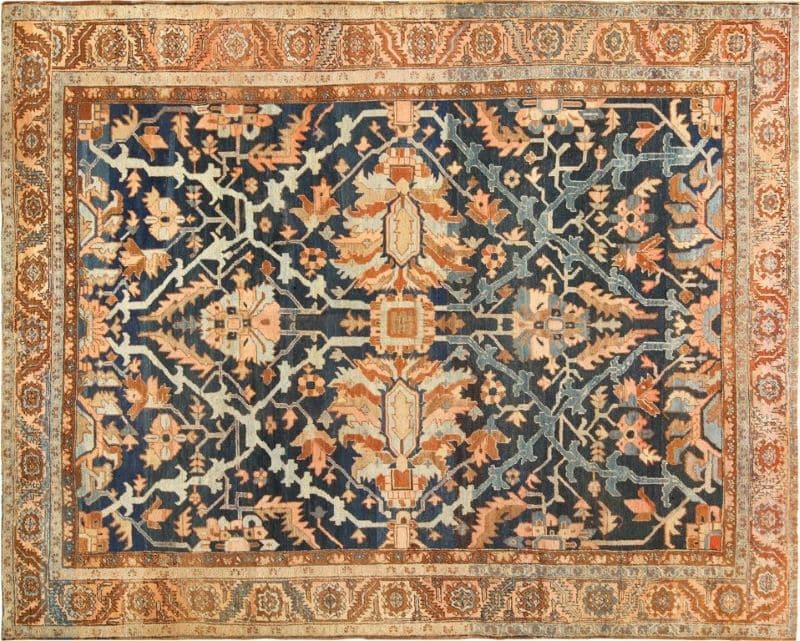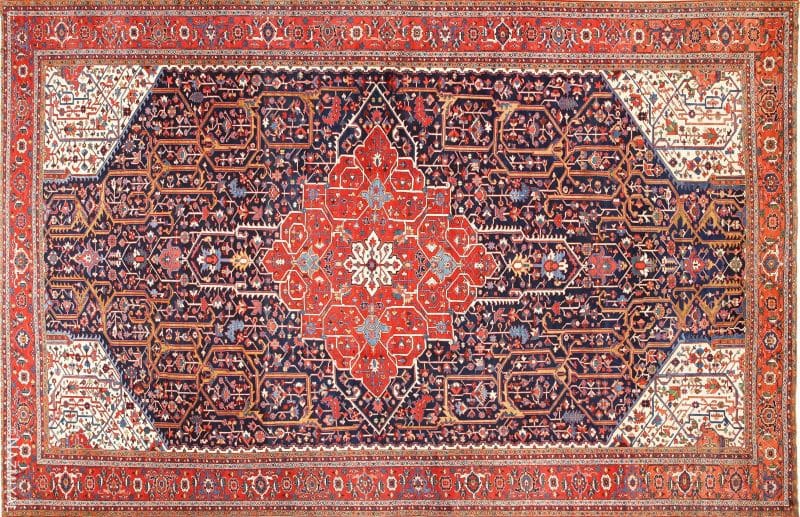Persian Serapi Rugs
Learn More About Antique Persian Serapi Rugs
View our Entire Collection of Antique Heriz, Serapi, and Bakshaish Rugs
The Persian Serapi rugs belong to a family of regional Persian rugs. These rugs were produced in the Iranian province of Eastern Azerbaijan and the area surrounding Heriz.
The village of Serab (or Sarab), where Serapi rugs are generally attributed to, is located south of the region responsible for the eponymous Heriz rugs – the region of North West Persia – and less than 80 miles east of Tabriz. The term Serapi is often applied to the finest antique rug examples from the Heriz area. However, the Serapi designation is a hot topic that is contested by many experts. Nevertheless, Serapi rugs particularly those produced prior to the turn of the 20th century are in high demand today.
The Serapi rug market designation originates from the village of Serab, which was known for producing extremely fine carpets decorated with traditional patterns and loosely spaced designs that prevailed in the area before workshops began catering to foreign tastes. Serapi rugs are chic, often with open designs. These unique rugs represent a wonderful combination of tribal patterns from the Caucasus along with early Safavid influences. Unlike the boldly colored and lavishly decorated rugs produced in the greater Northwest Persian region, Serapi rugs and Bakshaish rugs feature a variety of symbolic patterns rendered in a combination of light colors, neutrals and stark camel brown.
Antique Serapi rugs were made by small workshops and families, which resulted in formal Persian carpets as well as those with rustic tribal influences. Local production methods contributed to the characteristic abrash that adds a textural appearance to the stark field and contrasting decorations seen in many Persian Serapi rugs. These fine antique carpets were made in many sizes and shapes ranging from elongated corridor carpets to highly desirable room-size rugs. Persian Serapi rugs feature clear colors, creamy un-dyed fleece beautifully tempered reds, warm earth tones and concentrated blues. Largely produced before 1910, antique Serapi rugs feature rustic patterns, exceptional colors, high-quality wool and impeccable construction, which resulted in their coveted reputation for quality and value.
The region where the Serapi rugs are crafted is in North West Iran. Years ago when the largest number of these hand woven works of art were being crafted, they were made in the same region responsible for Bakshaish rugs and Heriz Rugs: the region of Heriz.
Unlike most carpets that are antique, the Serapi rugs are not named after the village where they were created.
The roots of carpet weaving have been traced back to somewhere around 5,500 B.C. That said, Persian rugs did not start to be really well known until around the world until the late 16th century. Some argue that the Heriz Serapi rug and the Serapi rug was once been labeled as a Serab rug, a separate antique rug style.
Those people claim that when the American merchants began to buy and trade in these items they translated the name incorrectly and the Serab rugs were renamed “Serapi” (because of this mispronunciation of the word). This may be the truth of how the name changed.
But there is also a tale of a Prince arriving in India aboard a ship called the Serapis and that his visit inspired the people of the region to call the carpets Serapi after his ship. regardless of if this is true or not, that is a much more romantic story.
The Serapi is well known for its strength and durability. There is a folk tale that says the carpets are so strong because the sheep that produce the wool drink from streams that have copper in the water. The tale goes on to explain that the copper from the water is supposed to influence the wool that the sheep produce and make it stronger than ordinary wool from other sheep.
But that is a folk tale and while it sound nice and interesting, it probably is nothing more than fiction. The truth is that late 19th century Serapi rugs were made by hand and the weave is tight and compressed.
The wool that was used was generally of a high grad and each knot was strategically made and pulled to the exact tightness needed to form a carpet that is strong and will stand the test of time.
You will notice that almost every Serapi carpet has a central medallion motif. This was a common motif of the area and the time. Many of the Serapi designs are created from the natural wool colors.
Browns, blacks, and the creamy tan colors were very popular in the areas where Serapi carpets were created and the fact that the wool was left un-dyed also increased the durability of the rug.
Some of the Serapi’s wool was dyed to create brighter and different colored motifs. The dyes that were used were cultivated from natural elements that were prevalent in the area.
The natural plants and flowers of the area were crushed and boiled with the wool to create colored threads for the creation of the colored motifs. A Serapi is a priceless treasures from a time gone by.
Serapi Carpets – The rug market has never been short of imagination in developing narratives to explain carpet formats, structures, or typological labels. One of the most amusing examples of this is the notion that rugs or kilims woven in separate halves sewn down the middle were made as wedding rugs with one half woven by the groom’s family.
The other woven by the bride’s, and the joining of the pieces as a symbol of the marital union itself. In reality, rugs were produced this way because no wider, large-scale looms were available, and the story evolved to explain away the annoying middle seam to potential customers.
Nowadays colorful stories like this are only repeated as amusing anecdotes, rather than as a strategy to make a sale. But one of the most groundless origin tales ever dreamed up has proven to be remarkably persistent – the idea that Northwest Persian weavers in the late nineteenth century made a type of carpet called “Serapi.”
This is all the more astounding given the fact that today Serapi rugs are among the most expensive and sought after room-size antique Persian rugs. A serape is a type of Mexican wrap-around garment or poncho, but this has nothing to do with the rugs.
In the Persian language Serapi is an adjectival form of Serap, but simply put, there is no such place. There is a village in North Persia called Serab, which is well-known for runners with highly geometric medallions on a natural camel ground, but these are quite different than the carpets commonly referred to as ‘Serapi.’
Serapis are to all intents and purposes a particular type or grade of what are called Heriz rugs – more specifically the highest grade in terms of weave, and very probably the oldest type in terms of age. Heriz carpets are generally coarsely woven with as few as 30 knots per square inch.
They also have a deeply depressed warp structure with a markedly ribbed back surface. Since the early twentieth century they have come to make use of light blue cotton wefting. Serapis, in contrast, have a higher knot count, sometimes attaining 80 knots per square inch.
Their backs are relatively flat, and they have ivory cotton wefting. Generally they have a softer floppier handle than Herizes, and they are thinner.

Antique Blue Persian Heriz Serapi Rug
In terms of design, drawing, and coloration as well, Serapis are clearly part of one and the same tradition as Herizes, despite being a distinct antique rug style, which originated as a Northwest Persian adaptation of early Sarouk Farahan medallion room-size rugs, but with a more geometric, abstract, village sensibility.
Like Herizes, Serapis have a multiple concentric medallion format that emits jutting branches or vines ending in large stylized palmettes, leaves, or flowers, with framing cornerpieces at the periphery of the field. The main border is usually some variant of the ‘turtle’ vinescroll pattern. In terms of design, what distinguishes Serapis from Herizes is once again their more refined approach. The articulation of the medallions is crisper, more finely linear, and open.
The vines are more finely proportioned, and there is more open space in the field, allowing the large leafy palmette forms to stand out with greater clarity and elegance. The same distinctions are apparent in the treatment of the borders. On the whole, it appears that what we call Serapi carpets are simply the oldest, most well-designed, and finely woven Herizes. So then why do they have a different label?
The answer probably lies in the twentieth-century development of Heriz production and its perceived standing within the Oriental rug market. After about 1920, there was a noticeable overall decline in the quality of Oriental rug production stemming from the introduction of synthetic dyes, machine spun wool, and vastly increased production in response to Western demand.
Within this process Heriz rugs, with their coarser structure and bolder, more large-scale designs naturally lent themselves to more rapid and less careful manufacturing standards, and their production came to consist largely of middle and lower grade weaving. They rapidly emerged as the budget Oriental carpet.
One has only to look at the numerous old and semi-antique Herizes still around today, with their faded dyes, coarse, often loose technique, blocky drawing, and unimaginative designs, to see how far they had slipped from the examples of the later nineteenth and early twentieth centuries.
By mid century no average western rug buyer interested in acquiring a quality piece would have thought that a new or used Heriz rug would have served such requirements. In 1900 a new Gorevan Heriz was regarded as a high-grade product, but half a century later a Gorevan had come to be regarded as an inferior production.
So far as one can judge, the term Serapi first appeared in the early 1950’s, and it was clearly coined by rug dealers. Given what was outlined just above, we can easily see what motivated them.
These dealers knew that old and antique Herizes, i.e. those that were then around thirty to fifty years old, were fine rugs. But the newer production had tarnished the popular reputation of Herizes.
It would not have been easy then to persuade high-end customers who were not aficionados that Herizes had once been much better rugs. The easiest alternative was to coin a new Persian term for the finest oldest Herizes, that could rapidly acquire the reputation and prestige of a first-class Oriental rug.
The village of Serab would do nicely. Its products were less numerous and less familiar, and there may even have been some high quality early camel-ground Herizes that could appear to justify a connection with Serab. Change the final ‘b’ to a ‘p’, add an adjectival terminal ‘i,’ and voila, we have a new antique rug name with an authentic ring.
The rest is history, as they say. For the past half century, Serapis have maintained their status as high-end antique rugs. A Serapi is “better than a Heriz.” The price of a Serapi in good condition has climbed dramatically of late.
Consequently, dealers are still inclined to label their best looking older Heriz rugs as Serapi carpets, even if they have ribbed backs and light blue wefting. But in all honesty, there just ain’t no such animal.
So What Are Serapi Carpets?
Serapi Carpets are the same as Heriz rugs, plain and simple!
If we can recognize that some Mahals, or Kazaks, or Oushaks are better than others, we ought to be able to do so in the case of Herizes without applying a bogus label to facilitate the distinction. Of all the legends of the rug trade, the tale the Serapi seems the hardest to shake off.
View Pictures Of Antique Persian Heriz Serapi And Bakshaish Rugs


